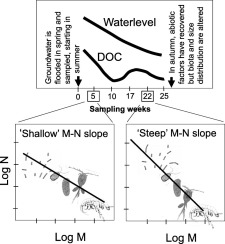Science of the Total Environment ( IF 8.2 ) Pub Date : 2018-10-16 , DOI: 10.1016/j.scitotenv.2018.10.216 Julia Reiss , Daniel M. Perkins , Katarina E. Fussmann , Stefan Krause , Cristina Canhoto , Paul Romeijn , Anne L. Robertson

|
- 1)
Aquifers are recharged by surface water percolating through soil and rock and by connections with surface streams and rivers. Extreme rainfall can cause extensive flooding of surface waters and, eventually, of groundwaters. However, how the resultant changes in nutrients impact groundwater organisms and the structure of groundwater food webs is largely unknown.
- 2)
We monitored abiotic (nutrients, temperature and more) and biotic (all organismal groups except viruses) conditions in eight groundwater boreholes in two locations in a chalk aquifer over the course of 25 weeks (ten sampling occasions), following an extreme rainfall- and groundwater-flooding event in the UK.
- 3)
We show that groundwater flooding can cause substantial nutrient fertilisation of aquifers – nutrient concentrations (especially dissolved organic carbon) in the groundwater were highest when we started the sampling campaign, directly following the flood event, and then decreased over time while groundwater levels also declined back to their baseline.
- 4)
Bacteria in the open water (i.e. bacteria not associated with sediment) became more abundant as the water table and DOC concentrations decreased. Importantly their functional richness tracked the DOC patterns, illustrating that bacteria were responsible for respiring DOC. Microbial metabolic activity and bacterial respiration, measured using smart tracers, supported this finding; DOC and microbial respiration showed a positive correlation.
- 5)
The other biota (protists, micro- and macro-metazoans) showed different abundance patterns over time, but importantly, the entire sediment community, ranging from bacteria to macrofaunal species, showed a strong community size structure (mean size spectra slope: −1.12). Size spectra changed gradually through time towards steeper slopes, except in the very deep aquifer.
- 6)
Our approach allowed us to demonstrate that groundwater communities track extreme changes in their usually stable environment, highlighting that they potentially buffer environmental change, although we still do not know what the limits of this ‘service’ might be.
中文翻译:

地下水泛滥:极端补给事件发生后的生态系统结构
- 1)
通过渗入土壤和岩石的地表水以及与地表溪流和河流的连接为含水层补给水。极端降雨会导致地表水泛滥,并最终导致地下水泛滥。但是,养分的最终变化如何影响地下水生物以及地下水食物网的结构尚不清楚。
- 2)
在极端降雨和地下水之后的25周内(十次采样),我们在粉笔含水层中两个位置的八个地下水井中监测了非生物(营养,温度等)和生物(除病毒以外的所有有机物)的状况。在英国发生洪水事件。
- 3)
我们表明,地下水泛滥会导致含水层的大量养分施肥-洪水事件发生后,当我们立即开始采样活动时,地下水中的养分浓度(尤其是溶解的有机碳)最高,然后随着时间的推移而下降,而地下水位也回落达到他们的基准。
- 4)
随着地下水位和DOC浓度的降低,开放水中的细菌(即与沉积物无关的细菌)变得更加丰富。重要的是,它们的功能丰富性可追踪DOC模式,说明细菌是呼吸DOC的原因。使用智能示踪剂测量的微生物代谢活性和细菌呼吸支持了这一发现;DOC与微生物呼吸呈正相关。
- 5)
其他生物区系(原生生物,微型和大型metazoans)随时间显示出不同的丰度模式,但重要的是,整个沉积物群落(从细菌到大型真菌物种)都具有很强的群落大小结构(平均大小谱斜率:-1.12) 。尺寸谱会随着时间的推移逐渐向更陡峭的坡度变化,除非在非常深的含水层中。
- 6)
我们的方法使我们能够证明地下水社区在其通常稳定的环境中跟踪极端变化,突显了它们潜在地缓冲了环境变化,尽管我们仍然不知道这种“服务”的局限性。











































 京公网安备 11010802027423号
京公网安备 11010802027423号